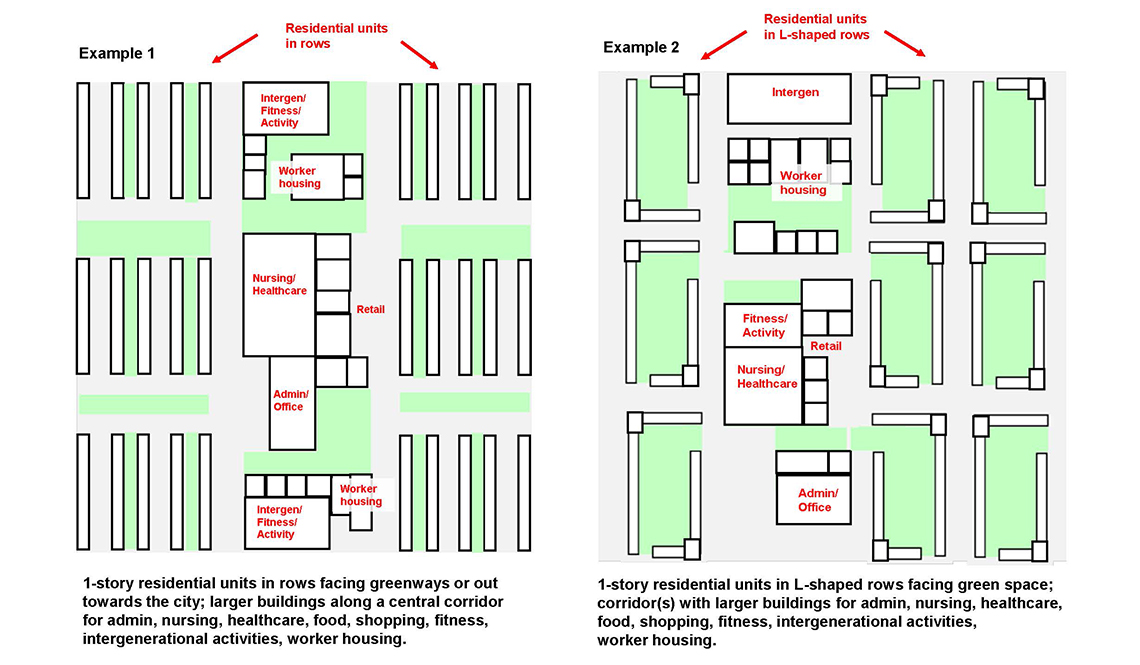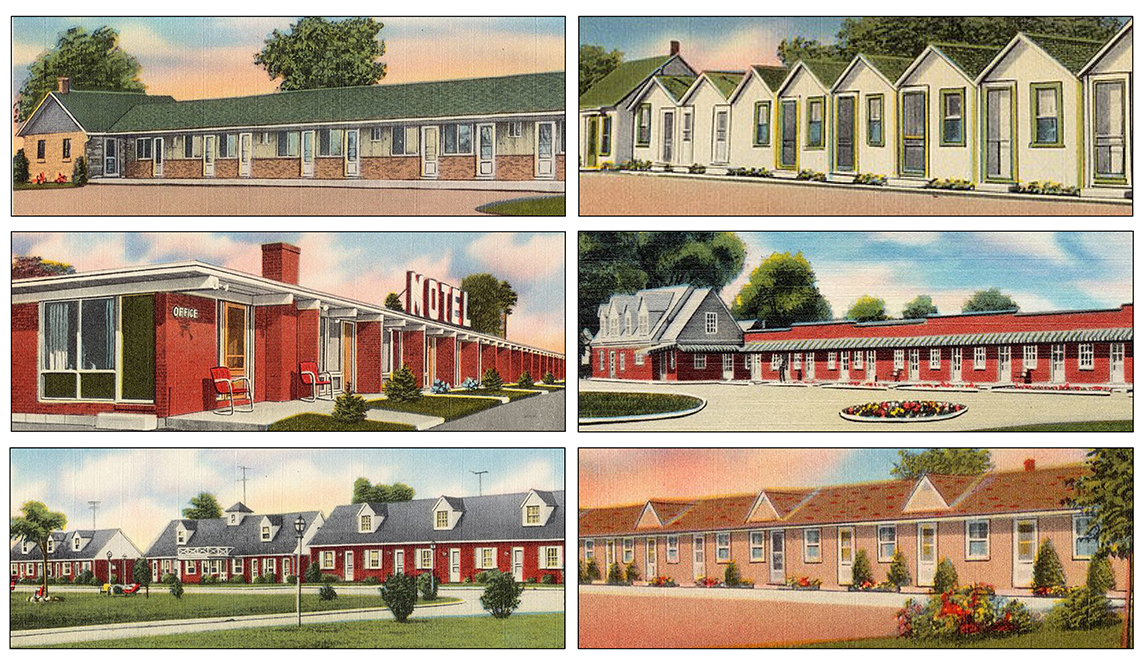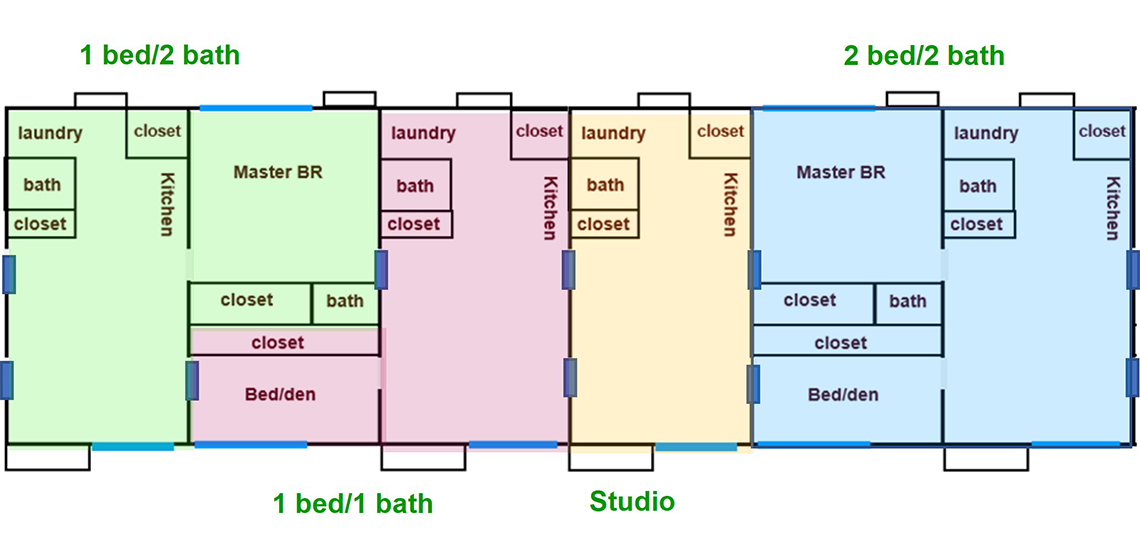A Reader Sent Us Her Idea for a Dream Home and Community for Aging. You Can, Too!
In Kitty Russell's motel-based model, walkability, social connectivity and age-friendliness are key
Virginia resident Kitty Russell, 69, popped us a note praising The ABCs of ADUs, a free AARP publication about accessory dwelling units.
In doing so, Russell, a retired administrative worker, shared a brochure she had created about the kind of later-in-life housing and community she wished she could find. We found her idea interesting and her creativity inspiring.
Russell's friends refer to her imagined motel-style housing complex as "Schitt's Creek for old people." The reference is to the television series in which a once-wealthy couple and their spoiled adult children end up living in a motel in Schitt's Creek, a small town they once purchased as a joke.
Scroll down to read about and look at Kitty Russell’s housing and community solution for older adults — and then learn how you, too, can share an interesting, inspiring wish or solution.
An “Urban Retirement Motel Community”
Kitty Russell’s mom, Alice, passed away at age 93 after spending six years in a senior care facility. While Russell was grateful for the wonderful care her mom received, she was certain she did not want to live out her own senior years in a similar setting.
THE MOTIVATION
"Today's premier retirement communities offer luxury living with food, activities, transportation, healthcare and other services for an aging population," Russell observes. "Most seem to fall into two categories: high-rise living in big buildings with lots of residents and amenities for their care, and single-family living in a resort-like setting, with higher levels of care provided in large buildings on the campus."
Russell's housing plan addresses criticisms she learned in her casual research. "I've heard over and over from retirees that they don't want to live in a place 'with a bunch of old people,’ or in a place that is separate from the larger community," she says.
THE IDEA
Russell used PowerPoint to create a diagram of a building akin to a traditional low-rise motel. She then placed several of the single-story structures in rows of small units in a grid, each facing a greenway or out toward the city. (See the diagram below.)
"Such a development could provide quality-of-life aspects that are missing from current retirement living models and still be space-efficient for a city environment," says Russell. She adds that the "urban retirement motel community" would include a central corridor of taller buildings for administrative and healthcare services, intergenerational activities and perhaps even worker or caregiver housing.

Illustration by Kitty Russell
"An urban retirement motel community would have single-story living in rows in a grid," Russell states in her pamphlet. "Each row would face a greenway or out toward the city. The campus would also have buildings for administration, resident activities and higher levels of care. (Click on the image to enlarge the view.)
LOCATION, LOCATION, LOCATION
The community would be located in either a city or a town, and not in a car-centric suburb or exurb. A commercial area or hub containing needed and desired amenities and businesses would be within walking distance of the residential units. Says Russell: "I could see something like creating the community in a vacant city lot, so the community fits into the space but the rest of the city is all around it, with people going about their business, doing their thing."
THE MOTEL MODEL
"When there's a housing crisis, such as when a fire destroys an apartment building, the displaced residents are often housed in motels," Russell notes. "People look at the existing, often not well-maintained motels and see their potential. In many places, motels are already being converted into affordable housing. The idea is out there. Just maybe not the idea of also including spaces and services for retired people.”
THE BENEFITS
Russell lists the following features as "desirable to this retiree."
- to have "a piece of earth, to breathe fresh air, to walk in from the outside"
- to have a room with a view, facing the city or a greenway
- to live in the city
- to have my own place, but for someone else to maintain it
- to have transportation options — and a place to park my car
- to be close to shopping, food, things to do
- to have access to healthcare and other services as I need them
- to stay connected to the larger community
- to have neighbors of all ages, not just old
- to have housing available at a price I'm willing and able to pay
THE OBSTACLES
Russell acknowledges that her solution isn't for everyone.
- People who are used to living in a big house may find it both unappealing and difficult to live in a smaller space.
- Also, many people aren’t willing to downsize — until they have no choice not to
- "You can fit a large number of people in a small but expansive space by using a grid and by limiting the size of the places," Russell points outs. "Yes, it's breaking a common rule because you're not building up."
- Residential zoning that allows only detached single-family housing — and not any type of connected or multiunit housing — is a policy preventive that would not allow Russell's pretend project. (The county she resides in has been discussing a proposal to allow the creation of more mid-sized, multifamily home options, such as Missing Middle Housing-style homes.)
PERSONAL PLANS
"The community I now live in is as close to my urban retirement village as I think exists," says Russell. "I'm in a 600-square-feet space, with my own entrance. I can walk to the hub, which has everything — restaurants, doctors' offices, a grocery store, a pharmacy, a pub where the artists hang out. My home is close to the model I imagine but it doesn't have the infrastructure for supporting aging."
Russell says she has gotten positive feedback to her idea from her single friends, some of whom have told her, "Sign me up!"
A real-world challenge, per Russell: "Finding a leader, or someone willing to take charge and run with the idea."
Not a challenge: "I have my eye on an old motel I think would be perfect for this!" she says.
We Asked Readers to Pop Us a Note
... with their housing or community solution. See what they said!
Reporting by Amy Lennard Goehner
Page published March 2023
Stay Informed — For Free! See Past Issues
The weekly, award-winning AARP Livable Communities e-Newsletter provides local leaders with information and inspiration for making their town, city or neighborhood more livable for older adults and people of all ages. Subscribe today!
AARP.org/Livable
Find articles, publications and more









